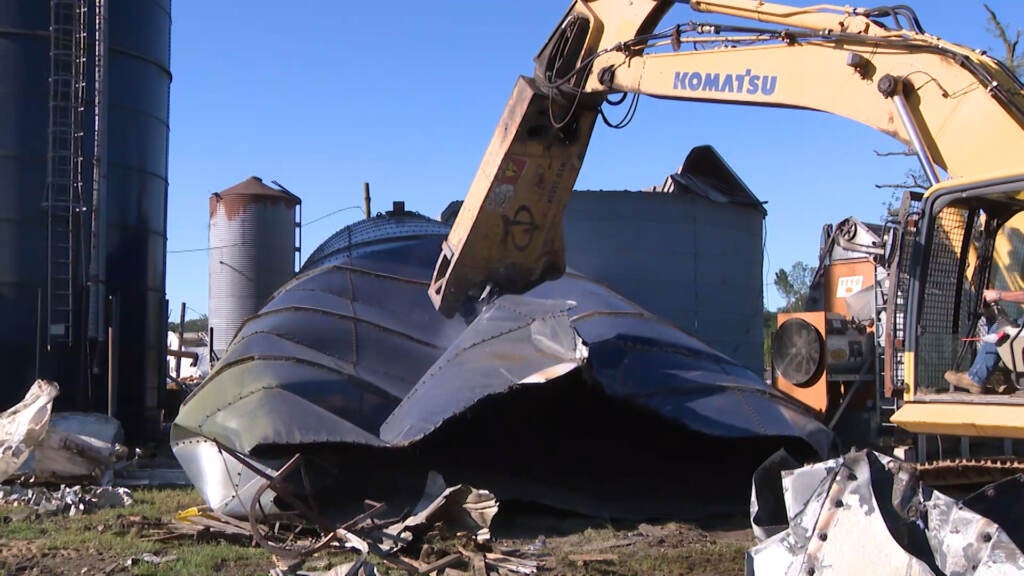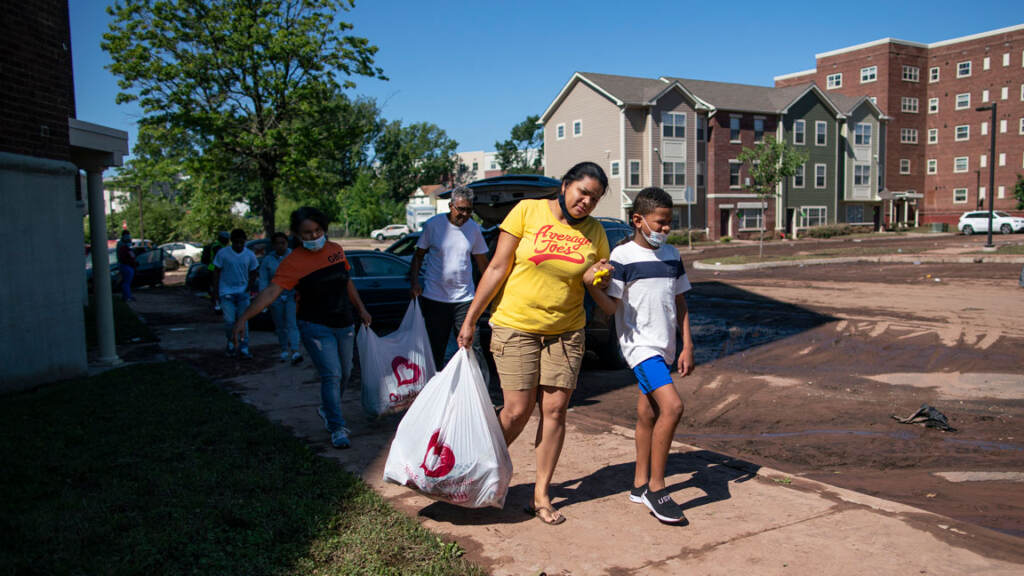Storm’s damage might boost support for more aggressive climate policy, experts hope
Policymakers urged to step up preparations for the next storm, and cut carbon emissions

Surveying the flooding from Tropical Storm Ida on Route 206 in Somerville. (AP Photo/Eduardo Munoz Alvarez)
This story originally appeared on NJ Spotlight
Will Hurricane Ida’s devastation persuade New Jersey policymakers that it’s time to move more people out of flood-prone areas, build roads in places where they won’t be overwhelmed by surging waters, or ensure that drinking-water plants have backups for use in case of storms? Climate experts hope the answer is “yes,” but they’re not putting money on it.
After record rains across the state last week led to more than two dozen deaths and millions of dollars in damage to property, the observers said it’s time for the state to accelerate its plans to adapt to a forbidding new climate of heavier rains, higher temperatures, bigger storms and rising seas. And it is time for the public to accept that events like Ida are likely to become more common as the climate changes.
A ‘teachable moment?’
Despite Ida’s severity, it’s not clear whether the storm is a “teachable moment” that will prompt state planners to speed up their preparations for a stark climate future, with the support of the public, even if the event may have increased people’s understanding of what the future holds.
“I could never welcome something that brings about the kind of destruction that we’ve had,” said Anthony Broccoli, co-director of the Rutgers Climate Institute. “Is it a teachable moment? Perhaps, although my impression over the years in the aftermath of incidents like this is that people are so focused on dealing with the immediate problems that it’s not clear to me that it really is a teachable moment.”
But when people have mopped out their flooded homes and cleared fallen trees from their yards, maybe they will conclude that the latest monster storm was in fact part of a pattern that will require huge changes in infrastructure, land use and population patterns in coming decades, Broccoli said.

“If a little bit of time passes and we can look at the big picture and not worry about all the things that have happened in the past 24 hours, and couple that with the knowledge that data show these extreme rain events happening more frequently and more intensely, that should motivate policymakers to think about what can be done to protect people,” he said in an interview last week.
Murphy’s climate efforts
The Murphy administration strongly defended its efforts to both reduce carbon emissions — “mitigation” — and to prepare the state for a changing climate — “adaptation.”
“The Murphy administration has been working tirelessly to reduce and respond to climate change, as is evidenced by multiple climate executive orders, ambitious clean energy goals and aggressive environmental regulatory reform,” said Kelley Heck, a spokeswoman for the state Department of Environmental Protection, on Friday.
The administration’s “80X50” report in April described how the state plans to cut carbon emissions by 80% by 2050, Heck said. That report, and the governor’s Energy Master Plan, make similar projections on carbon reduction to those of the Intergovernmental Panel on Climate Change, she said.
The latest IPCC report warns that climate impacts like Ida will continue in the near-term because of greenhouse gases already emitted, and those effects are likely to worsen without current mitigation efforts, Heck said.

The administration is working to ensure that new federal infrastructure funding is spent on climate-resilient projects, and is requiring all agencies to coordinate climate planning through its Interagency Council on Climate Resilience, she said.
In April, the state released a resiliency strategy describing 125 actions in six policy areas that it said should be adopted by public and private organizations to adapt to new climate conditions.
New rules on air, land use
To implement its response to climate change, the DEP is writing new rules on air and land use under its Protecting Against Climate Threats (NJ PACT) process. Stakeholder meetings on some proposed rules have concluded, and other regulations on the coastal zone, freshwater wetlands and flood-hazard areas are expected to be proposed by the end of this year, said Larry Hajna, a spokesman for the agency.
Gov. Phil Murphy said Friday that the state has spent $1.5 billion on stormwater infrastructure improvements over the last three years, and another $1 billion is coming over the next year. He said it was “no surprise” that major storms like Ida are happening more often, noting that they have long been predicted by climate scientists.
But changes such as stormwater improvements are likely to be only part of the response to climate change, said Howard Neukrug, chairman of the new Advisory Committee on Climate Change at the Delaware River Basin Commission.
Proactive measures
Neukrug, the former head of the Philadelphia Water Department, said policymakers including the DRBC need to be thinking about advocating population retreat from flood-prone areas like river towns or coastal resorts. They should also be considering whether to rebuild roads in vulnerable places and looking at investment in backup facilities for drinking- or wastewater plants that may get overwhelmed by floodwaters from future megastorms, he said.
His panel, which met for the first time in August 2020, has focused initially on how sea-level rise will affect the Delaware River, which is tidal as far upstream as Trenton. Water-supply experts are concerned that rising sea levels will push a line of saltwater close to the river’s drinking water intakes at Delran and in northeastern Philadelphia. Possible saltwater contamination has raised the idea that it might be necessary to move the water intakes further upstream, or to build desalination plants, he said.

The DRBC, which regulates water flows among the four basin states of New Jersey, New York, Pennsylvania and Delaware, can control water volumes by allowing releases from upstream reservoirs, Neukrug said. But water quality for the approximately 15 million people who depend on the basin’s watershed is determined also by the states and hundreds of local authorities that control land use, and may not be as cognizant of the effects of climate change, he said.
“It’s much bigger than an organization that’s responsible for storm management on the river,” he said.
‘Something terrible happened … and we need to hold on to this, and use it as a base for speeding up solutions’
Part of the huge challenge of climate adaptation in the Delaware River Basin could be addressed by an expected influx of federal infrastructure dollars, Neukrug said, but he urged policymakers to ensure that the money is spent on sustainable projects.
“We need to think about how to spend these extremely large amounts of money in a way that is equitable and recognizes that some roads and some buildings should not be rebuilt where flooding has already occurred,” he said.
Neukrug hopes that planning for such changes, including by his committee, will speed up as a result of the shock of Ida. “Something terrible happened two days ago, and made us very aware, and we need to hold on to this, and use it as a base for speeding up solutions to this,” he said. “I’m hoping that the committee can help make this a teachable moment.”
For Jeff Tittel, former director of the New Jersey Sierra Club, Ida was just the latest in a series of wakeup calls that he said have yet to convince policymakers and the public to make fundamental lifestyle changes.
Fossil fuels, flood zones
Tittel, who was unable to return to his Lambertville home during Ida because of the flooding Delaware River, said he hopes the storm will lead to big changes like ending fossil-fuel use or preventing homes from being built in flood zones, but there’s no sign yet that it will.
“We keep having teachable moments, and many people get it but other people don’t get it or are too tied to the fossil fuel industry and don’t want to get it,” he said. “Things are happening at a much more alarming pace. It’s getting worse, and it’s getting worse faster than people have realized.”
‘How many times do we have to have these wakeup calls for not only the public but the government to get the seriousness of the problem?’
Tittel argued that the state isn’t doing enough to cut carbon emissions or to prepare New Jerseyans for a grim climate future, despite the Murphy administration’s embrace of the budding offshore wind industry, and its goal of reaching 100% clean energy by 2050.

“Just building windmills and solar panels does not necessarily reduce greenhouse gases because you still have gas-fired power plants and pipelines being built, and automobiles, so we’re not really doing the mitigation to the level that is absolutely necessary to mitigate the damage from climate impacts,” he said.
Tittel, who ran the state’s Sierra Club for 23 years until he retired this year, said he’s angry about what he sees as insufficient action by the state to prevent another Ida or prepare the state for the next one.
“How many times do we have to have these wakeup calls for not only the public but the government to get the seriousness of the problem?” he said. “We’ve had these wakeup calls, the elected officials give their press conferences, and nothing really changes.”


Get daily updates from WHYY News!
WHYY is your source for fact-based, in-depth journalism and information. As a nonprofit organization, we rely on financial support from readers like you. Please give today.






